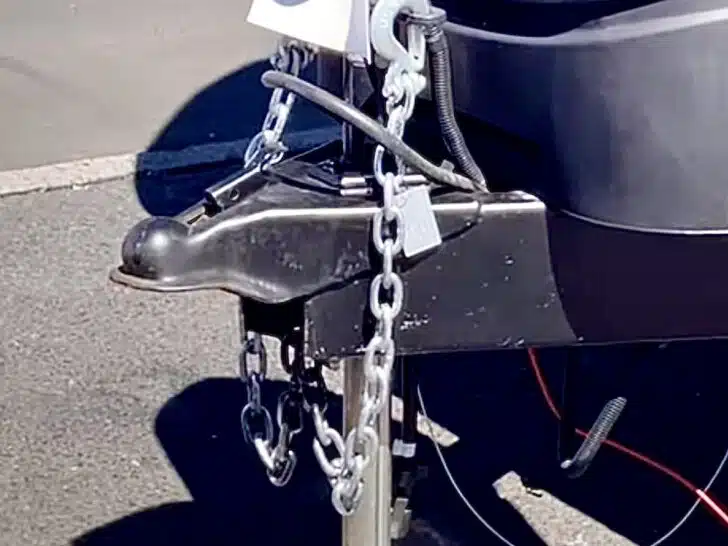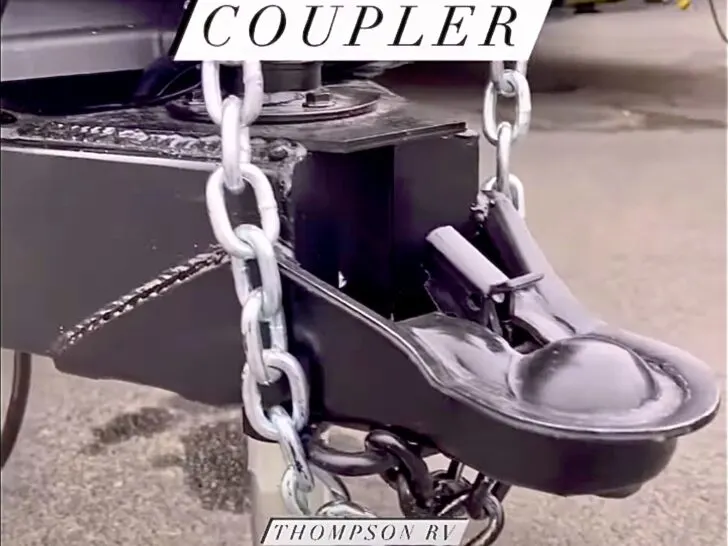Even if many people don’t know exactly what it’s called, pretty much everyone knows what an ordinary trailer coupler looks like. It’s that thing with the rounded top at the very front of nearly every travel trailer (or boat or utility trailer, for that matter) that sits directly onto a trailer hitch ball. We’ve all seen them. But did you know that those familiar-looking devices are almost always overslung trailer couplers?
But what does “overslung” mean, and what is an underslung trailer coupler? What’s the difference between them, and why might you want or need one vs the other? In this post, we’ll explain what an underslung trailer coupler is, how it functions, and the advantages it can provide for many travel trailer owners.
What Is a Trailer Coupler?
A coupler is a part of the trailer that’s either welded or bolted onto the very front, or tongue, of the trailer’s frame. It attaches to and sits over that familiar ball on your tow vehicle’s trailer hitch. The connection between the ball and coupler secures the two vehicles together, and also allows the trailer to swing to the left and right as you drive around corners. And, of course, it lets us disconnect the trailer from the tow vehicle when we reach our destination.
What Is an Overslung Trailer Coupler?
As mentioned, an overslung coupler is the type we’ve all seen forever. Its name (“overslung”) comes from the fact that it sits on top of the trailer frame, or over it. This is the way most couplers have been attached for ages.
In fact, the likely reason why so many people haven’t heard them referred to as “overslung” couplers is exactly because the design is so common. There hasn’t been any real reason to mention the specific coupler design when it’s been dominant for so long. It’s generally just been known as “A coupler.”

This is a typical trailer coupler – the type we’ve all seen since shortly after the invention of the wheel (surely the trailer coupler wasn’t far behind)! This device is technically known as an overslung trailer coupler because it’s welded or bolted over the top of the trailer’s frame rails.
What Is an Underslung Trailer Coupler?
An underslung trailer coupler mounts to the underside of the trailer’s frame, beneath the trailer tongue. These are generally a bit newer than the traditional overslung design, so it’s understandable that we see them so much less often. But there can be a couple of advantages over the old design, which is likely why we’re starting to see them more.
An increase in the size of some modern travel trailer frames and the popularity of off-roading both lend themselves to underslung coupler design. We love to boondock off the grid, so if we had a travel trailer, we’d prefer underslung vs overslung. We’re starting to see them a bit more often, and we think that’s a great thing!
This may sound like no big deal, as in “Does it really matter what type of coupler you have? They all pull the trailer!” So, let’s talk about the advantages of one design vs the other and why an underslung trailer coupler might be a better choice for many RVers.

This is an underslung trailer coupler. It gets its name from the fact that it’s welded or bolted underneath the trailer’s frame, which raises the tongue higher than overslung couplers (Photo courtesy of Thompson RV)
When Is an Underslung Trailer Coupler Needed, and What Are the Advantages?
There are a couple of specific situations where underslung trailer couplers are typically used, and have an advantage over an overslung design.
Trailers With Tall Frame Rails
Because a traditional overslung coupler positions the frame rails under the coupler, the front of the trailer sits lower in relation to the receiver hitches on typical tow vehicles. The taller the frame rails are, the lower the tongue will hang down. If a trailer has very tall frame rails, that can leave quite a bit of the tongue positioned lower than the hitch ball. The taller the frame rails, the greater the advantage an underslung coupler can provide.
Improved Ground Clearance
Because an underslung coupler raises the trailer tongue higher than the underslung style, clearance between the ground and the bottom of the trailer’s frame is increased. This reduces the likelihood of striking anything while towing. That’s especially important off-road, but there are plenty of times this could help during everyday driving. Entering or leaving a driveway or parking lot with a pronounced dip at the entrance is a good example of a trailer’s tendency to hit the ground near the hitch assembly.
When it comes to more rugged travels (like our love of boondocking far off the grid), that extra clearance can be even more important. Using an underslung coupler can be combined with other modifications to the trailer’s suspension to remove as many low points as possible to increase the overall clearance for off-road travel. It’s why underslung couplers are becoming more common on off-road, rugged RVs.
The new 2024 Outdoors RV Creek Side 21MKS Titanium Series pictured below comes equipped with an underslung coupler. This is an excellent choice for an RV with a robust build (tall frame rails) that’s designed as a capable off-road rig (better ground clearance).

The new 2024 Outdoors RV Creek Side 21MKS Titanium Series comes equipped with an underslung trailer coupler. This is a great choice for a solidly built off-road-ready camper. (Photo courtesy of Thompson RV).
Leveling The Trailer and Tow Vehicle
When we say “leveling” here, we’re not talking about getting our rig level at a campsite. We’re referring to the importance of having the towing vehicle and travel trailer level with each other during transit.
It’s typical for the weight of the trailer tongue to weigh down the rear of the towing vehicle. This can cause an unlevel towing situation, putting too much of the trailer’s weight onto the tow vehicle’s suspension. This, in turn, can result in too much sag at the rear of the tow vehicle, reducing the weight on the front/steer axle and resulting in a reduction of steering control.
Mounting the trailer coupler to the bottom of the frame does help raise the tongue, but it won’t significantly affect the tongue weight. So, a weight distribution hitch may still be needed. But, the underslung design can reduce the need for a RISE hitch.
Combining an underslung coupler and a weight distribution hitch will help reduce the amount of the trailer’s frame that extends down beneath the hitch connection point. You’ll appreciate the reduced likelihood of scraping into a driveway entrance (or a rock or wash if you’re traveling off-road).
Do Underslung Trailer Couplers Have Any Disadvantages?
A trailer that comes from the factory with an underslung hitch likely has only one potential disadvantage. That might be the case if your truck and hitch are especially high up. Moving the connection point on the trailer’s tongue even lower will raise the tongue even further. This may require a drop hitch… or an even taller drop hitch than you were already using.
If your RV came from the factory with an underslung coupler, or if you install one, you need to ensure that any other hitch components you have or plan to use (such as a weight-distribution hitch or sway control) are compatible with an underslung coupler. This is important because the location and configuration may change the angle and/or distance needed to attach other components to the trailer’s frame.
If you already own a weight distribution hitch that’s incompatible with an underslung coupler, that may require you to replace your hitch (and weight distribution hitches aren’t cheap). Spring bars and other components need to fit. So, this may be a disadvantage for you, depending on what gear you already own.
Proper Installation
The biggest disadvantage of an underslung coupler is when you want to retrofit one onto a trailer that didn’t come with one. It will likely require a combination of cutting, drilling, and/or welding.
Drilling holes for bolts isn’t the best choice, since drilling through the trailer’s frame can weaken it. But, not everyone has welding skills or equipment. That means additional cost to have a professional do the installation for you.
If you decide to install an underslung coupler yourself, be sure to adhere to all safety requirements and obtain detailed instructions on how to add underslung trailer hitches. Installing the hitch head correctly is crucial for towing safety.
For more details about safe trailering, check out our detailed posts on the following topics:
- Why Is Proper Trailer Hitch Height So Important?
- The Trailer Tongue & Coupler: Crucial to Towing Safety
- Trailer Sway Control
Free RVing Tips, Tricks, Reviews & Giveaways
As 20-year full-timers, we share everything we’ve learned about RVing over the years. Join our online community to receive a wealth of great RVing knowledge delivered daily to your inbox.
Whether you’re a new RVer or a seasoned full-timer, you’ll love the wide range of RVing topics we cover. Don’t miss a single article or any of our famous Giveaways. Subscribe to our newsletter today!


John S.
Friday 29th of December 2023
I have only seen one underslung hitch at an RV dealer. I thought it was a custom order for someone with special requirements.
Now I know they are a real thing.
TheRVgeeks
Friday 29th of December 2023
They certainly do look weird, John. You're right! In the past, they were primarily relegated to those RV owners who had a specific need for raising the clearance of their trailer tongue... so they were pretty rare. With the increase in the size (and weight) of travel trailers... the size of the chassis rails has made them more common!
It's good to keep learning... mental stagnation's dangerous! 😉
J dux
Friday 29th of December 2023
Another (minor) disadvantage is that it's harder to find hitch locks that fit properly. Make sure there's enough clearance to fasten the lock onto the hitch.
TheRVgeeks
Friday 29th of December 2023
Great point... thanks!